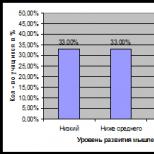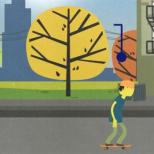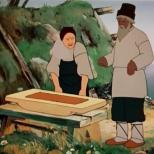What percentage of the trees are left on the ground. How many trees per person in each country in the world
There are more than 60 thousand species of trees on the planet. At least that's what the data says International Council for the conservation of botanical gardens. The information was published in Joumal of Sustainabel Foresty, and experts from more than 500 branches of Botanical Gardens Conservation International, scattered around the world, worked on its collection.
The creators of the list claim that about 58% of all registered trees are endemic, that is, growing on the territory of any one country. Most of them are on the verge of extinction due to the neglect of people, as well as climate change and various natural disasters.
Exotic in its purest form
Nature never ceases to amaze with its imagination, therefore it is extremely important to respect its “efforts” and think about how to preserve and increase everything that it has created.
It grows in Central and South America and belongs to the mulberry family. The local population actively uses its juice for food, which, despite the tropical heat, may not spoil for a whole week. In its consistency, it resembles a viscous liquid, half consisting of water and vegetable wax. The remaining 5-7% are sugars and resins. It has a slightly balsamic aroma.

"Milk" is usually diluted with water, and the proportions depend on what will be prepared from it: first courses, drinks, medicinal tinctures, and so on. When it is boiled, wax is separated on the surface, from which candles and chewing gum are made for whitening teeth.
Heritage of the West Indies and the Florida Peninsula. The name literally means "Indian soap". By appearance the fruits of this plant resemble small oranges or orange plums. They tightly stick around the branches of a tree, hanging in abundant clusters.

The Indians were well aware of its soap properties, actively using the fruit as a kind of washing powder. Pounded in a mortar, "nuts" mixed with water, forming a thick foam. Interestingly, things processed in such a solution do not shed or fade even with repeated washing.
Or as it is called scientifically - edible parmentiera. Homeland - the Isthmus of Panama, uniting the North and South America. The plant owes its name to the Spaniards, who first began to use it for household needs. Although the fruits of this taste amazing tree are also very pleasant. The pulp vaguely resembles a ripe apple, loose and sweet.

The "candles" themselves look like long yellow cucumbers, and they stick out straight from the trunk, and do not hang from thin branches. Some specimens can reach up to 1 meter in length, turning into such giant bean pods. The fruits contain a large number of various vegetable oils, which causes them wide application as natural candles. If you insert a wick inside, then such a “lamp” will burn for a long time, brightly, evenly and without soot.
Another "delicious" creation of nature, living in Mexico, the Mediterranean countries and the Crimean peninsula. Its botanical name is large-fruited strawberry. Assigned to the heather family. At different peoples there are their own versions of the "nicknames" of this colorful plant - for example, a spa or shameless.

And all because the tree tends to change the outer layer of the bark every year, exposing the trunk. Moreover, under the influence of sunlight, the plant seems to tan, and the initially green young bark acquires a reddish-brown hue by the end of the season. The bark peeling off in tatters sways in the wind, creating rustling sounds, and that the tree has received another nickname - the whisperer.
Strawberry fruits are very tasty and juicy. Visually, they really resemble strawberries, gathering on the branches with voluminous inflorescences. They make jam, marmalades, marmalades, as well as various liqueurs and wine. But the tree grows quite slowly. At ten years of life, it can rise above the ground by only 2-2.5 meters, and double in height only at 50 years old.
The scientific name is brachychiton. The first association that arises at the sight of this unusual plant is a giant vase with a green crown at the top. A convex "bottle" can grow up to 10-15 meters in height, which further adds to its phantasmagoria and scale. The diameter of the trunk is also impressive, which is often three meters.

The tree grows mainly in Eastern Australia and is very revered by the local population. Brachychiton leaves are an indispensable tool in the household of Australian farmers. In the dry months, they are fed to livestock, but the change, extracted from the pods, is already eaten by people - they are fried or eaten directly raw. Various dishes are prepared from the roots, and the juice downloaded from the trunk cavity is used to prepare nectars, desserts and compotes.
His homeland is the island of Saint Helena, located in southern waters Atlantic. It was here that the notorious Napoleon Bonaparte languished in exile, and it is here that another unusual view trees - tree daisies. Interestingly, this tree has nothing similar in taste to the famous and beloved vegetable. Its leaves are not eaten at all, but outwardly they have very characteristic dense inflorescences, collected in tight "balls" at the ends of the branches.

Archaeological excavations confirm that the tree has been growing on the island since prehistoric times and, apparently, was used in cooking by ancient people. To date, the plant is among the island endemics and is on the verge of extinction.
But the cabbage tree, or southern cardilla, growing in the vastness of New Zealand, is very edible. It has chosen not only the damp low-lying plains, but also perfectly adapted to the mountainous terrain. The leaves of this tree have a high content of carbohydrates in their composition, so many tasty and nutritious dishes are prepared from them. Most often, they are baked in specially equipped ovens and served with different sauces. For long-term storage, the leaves are dried in the sun and stored in closed containers.
Or, as it is also called scientifically, kigelia. The African giant got its nickname because of the original fruits hanging down in thick sausages right to the ground. Fatty liver sausages reach a length of up to 60 cm, and they are also quite noticeable in weight - an average of 1.5-2 kilograms. No less original look and flowers of the tree, pollinated bats and blooming for just one night.

Africans have long adapted to extract from sausage tree maximum benefit. Since the fruits are not consumed fresh due to their strong laxative effect, they are soaked, fermented and subjected to other processing. To prepare various dishes, "sausages" are fried, steamed, dried and soaked in water. They also make all kinds of alcoholic tinctures, adding wild honey and fragrant spices. The bark and leaves are used to make potions for bites. poisonous snakes, as well as for the treatment of rheumatism and wound healing.
A lot of interesting plants also grows in Russia, some of which are listed in the Red Book and protected by UNESCO.
Until recently, the question “How many trees are on Earth?” one could succinctly answer "many". But modern technologies and globalization have helped answer this question.
With the advent of satellite images, for the first time, experts were able to examine the surface of the planet in detail for the presence of forests and gave a rough estimate of the number of trees on our planet: about 400 billion. These data did not raise questions until a ground-based expedition of environmentalists decided to count the number of trees in the Amazon River basin. More detailed analysis data showed that 390 billion trees grow in this area - almost the same as on the entire planet, based on analysis of satellite data.
The Dutch ecologist Thomas Crowther, who, together with his colleagues, decided to finally clarify the question of how many trees grow on the planet, could not come to terms with such a scatter of data. A group of environmentalists concluded that satellite imagery in some regions, the true number of trees in a given area is greatly underestimated, since dense canopies can hide smaller trees growing under them, and relying on average data for the area would again give unreliable data.
According to Thomas Crowther, the only way out was to organize a global survey of all the forestry enterprises of the planet about the number of trees growing in the territories under their control, since nowadays almost all states have a similar division of forest areas.
Despite the apparent obviousness of the solution to the issue of counting trees, it becomes clear why no one has done this before. similar work: Thomas Crowther and colleagues had to collect information from 400,000 forestries around the world. The data collection took 2 years, and after calculations, scientists got a mind-boggling number in 3.04 trillion trees!
This is interesting: according to the data obtained, the largest number of trees is in Russia, Scandinavia and North America.
It remains to understand why ecologists even needed to look for the number of trees on Earth. Of course, to save the environment. The matter is that every year for the needs the mankind cuts down about 15 billion trees. Now, knowing the total number of trees and the rate of their felling, we can better control and calculate the process of reforestation.
Trees - an important part life on the planet, they occupy about a third of the land. Forests on Earth have evolved for 180 million years. Since the continents were originally concentrated in the Southern Hemisphere and were located close to each other, trees became ubiquitous.
The forest area covers approximately 38 million square kilometers. 22% of the total number of trees on the planet is concentrated in our country. Concerning European countries, then Finland is the richest in forests (they make up almost ¾ of its territory). The fewest trees in the UK (about 6%).
The focus of forests in Russia is Siberia, the area of forests in its space reaches almost 8 million square kilometers. It is important to understand how many trees are on the ground as they are the consumer carbon dioxide and a source of oxygen for all living things. It is necessary to preserve natural resources and use them rationally. The taiga regions of Russia absorb 15% of all carbon dioxide concentrated on the planet.
In total on Earth this moment approximately 417 billion trees. The world's population is currently just over 7 billion. This means that there are approximately 60 trees for every person.
It is important to understand that the forest is ours natural wealth. Uncontrolled deforestation poses a threat to the atmosphere and human life in general. About 95 million trees are cut down every year around the planet. It seems that there are quite a lot of trees, but in fact this is far from the real state of affairs. Previously, they were distributed everywhere, but with the development of civilization, their number is steadily decreasing. The needs of the population are growing every year. Most of The forest area is used to meet agricultural needs, to provide housing, in order to expand cities. The preservation of the forest cover is largely maintained due to the undeveloped space. There are especially many such territories in our country.
According to the World Resources Institute, there are approximately 100,000 various kinds tree species, of which 8,000 are endangered.
Trees play a huge role in providing life on Earth. Forests regulate the climate on the planet, distribution nutrients, are an important source of resources. Through their vital activity, the air is purified, the Earth is supplied with oxygen. Trees contribute to the retention of moisture in the soil, it is an important component of ecosystems. Forests are natural environment habitat for many animals and plants. Among other things, woodlands are the epitome of natural beauty.
Calculations and recent research have revealed some pretty shocking results regarding the number of trees on the planet.
There are about 3 trillion trees currently growing on Earth, according to Yale University researchers. Just imagine the number 3,000,000,000,000. Wow!
This is seven times more than previously thought! And approximately 422 trees for every person in the world. Pretty good, right? Unfortunately, the researchers also estimate that this is only half the number of trees that were on the planet before humans appeared.
So how did scientists get these numbers? A team of international researchers from 15 countries used satellite imagery, tree surveys and supercomputer technology to compare tree populations around the world per square kilometer. The results are the most comprehensive tree count ever undertaken on Earth.
The study was inspired by the global youth organization Plants for the Planet, which aims to plant trees around the world to reduce the effects of climate change. They asked researchers at Yale University about the estimated global number of trees. At that time, scientists believed that there were about 400 billion trees on Earth, or about 61 trees per person.
But the researchers understood that this was an approximate number, since only satellite images and an estimate of the forest area were used for the calculation, but data from the ground were not taken into account.
Thomas Crowther, Research Fellow in the Department of Forestry and Environmental Studies and lead author of the study, put together a team that studied tree populations using not only satellites but also tree density information through national forest inventories and tree counts.
The researchers were also able to confirm that the world's largest forest areas are in the tropics. Approximately 43 percent of total number trees, grows in this area. Regions with the highest tree density include the subarctic regions of Russia, Scandinavia, and North America.
The researchers hope that this inventory and new data on the number of trees in the world will lead to increased awareness of the role and importance of forests, especially when it comes to biodiversity and carbon storage.
According to the study, deforestation, habitat loss and unsustainable use forest resources result in the loss of more than 15 billion trees per year. This affects not only their number on the planet, but also biodiversity in general.
It has been found that the density and diversity of trees decrease dramatically as the number of people on the planet increases. Natural factors such as drought, floods and insect infestations also play a role in forest loss.
“We have almost halved the number of trees on Earth, and this is clearly affecting the climate and human health,” Thomas Crowther said in a statement released by Yale University. "The study also mentions the need to do more to restore the health of our planet's forests."
Previously, it was believed that there were approximately 400 billion trees on Earth, that is, somewhere around 60 per person. Of the more than 3 trillion trees, approximately 1.39 trillion, or 46 percent, are tropical and subtropical forests, another 740 billion (24 percent) are boreal, or northern forests and about 610 billion (20 percent) to temperate forests.

In their work, scientists presented rough estimates of the number of trees by country. As expected, Russia became the champion in this indicator, where approximately 641.6 billion trees were counted - 4.4 thousand per inhabitant. Next come Canada, Brazil, USA, China, Democratic Republic Congo and Indonesia.
Scientists estimate that annually, the Earth's forest cover loses about 15.3 billion trees per year. total area in 192 thousand square kilometers - about one Malaysia, if you count in trees. The net loss, excluding reforestation, is about ten billion trees.
For these calculations, scientists used data from another study published in Science in 2013: its authors compiled a global forest map using Landsat satellite images, which can be used to track the change in the state of the planet's forest cover from 2000 to 2012. In particular, then it turned out that Russia at that time lost more forests than any other country in the world, and in total, almost one and a half million out of 87 million square kilometers of forest were destroyed on the planet by people, fires, hurricanes and pests.
According to new estimates, since the beginning of the existence of human civilization, that is, over the past 14-15 thousand years, forest cover has almost halved: the total number of trees has decreased by 45.8 percent.

Thomas Crowther of Yale University says he got the idea for the study from the youth environmental movement Plant for the Planet. Two years ago, activists turned to an American scientist with a question about total of trees on Earth to better represent the relative contribution of their global Billion Trees campaign.
“I was afraid that the results of the study might disappoint activists, they say, a billion trees are still a drop in the ocean, it's pointless. It turned out to be quite the opposite: now that they know that there are three trillion trees on Earth, and this is about half less than it was before human intervention, they simply set out to plant a trillion, not a billion trees, ”Crowther told reporters.
The campaign was launched in 2006 by the United Nations environment, and since then the participants, according to the organizers, have already planted about 14 billion trees - that is, almost compensated for the net loss of forest cover in a year and a half.
In total, scientists from 15 countries participated in the study. Russia was represented in the team of authors by Elena Tikhonova, Senior Researcher, Laboratory of Structural-Functional Organization and Sustainability forest ecosystems Center for Problems of Ecology and Productivity of Forests of the Russian Academy of Sciences.





